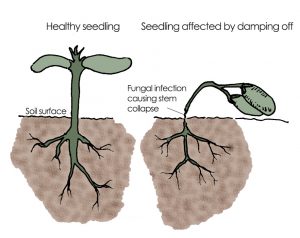a. Explain what is meant by the term physical pest control.
b. State TWO Benefits and TWO limitations of the use of physical pest control methods in a garden compared to using chemicals, by completing the table below.
Answer
a.
Physical pest control includes the removal of pests from plants, for instance, lily beetles, or erecting a physical barrier to prevent the pest reaching the crop, an example is the cardboard bands placed around apple trees which trap Codling moth larvae beneath then. The bands can then be removed and destroyed.
b.
Physical Control – Benefits
(Note this question asks for only two benefits and two limitations, we have listed more here, but in the exam they will only consider and mark the first two.)
- safe for the environment – does not cause pollution or risk damage to beneficial insects
- safe for the operator – the operator does not need to handle chemicals
- no build up of resistance
Physical Control – Limitations
- A knowledge of the life cycle of pest is required
- barriers can make access to the crop more difficult, for instance, for maintenance and harvest
- crop may be damaged if infected material is removed
- labour intensive to apply on a commercial scale, increasing cost of crop production.
Chemical Control – Benefits
- fast acting and can be chosen to be pest specific
- if used correctly, chemical targets pest at its most susceptible in its life cycle
- chemicals can be applied as a preventative measure
Chemical Control – Limitations
- Pests and may build up a resistance to the chemical over a period of time
- Chemicals may cause damage to plants in the area
- Chemicals may harm beneficial organisms and also pets if not used safely
- Chemicals may accumulate in the environment
- Chemicals may enter water courses, causing water pollution and impacting aquatic life.
Background
Physical control methods are techniques that prevent the pest from reaching a crop, trigger behavioural changes, or cause direct pest damage or death. As technology advances, physical control methods are becoming more effective and important to growers.
Physical control methods can be defined as either passive or active. Passive methods cause changes in the immediate environment and can act over a prolonged period.An example would be when carrots are protected from carrot fly by use of a crop cover. Barriers used in the garden or field can take several forms, including trenches, oils and sticky traps. They can be used to protect just one plant or they may be used on a much larger scale to protect a complete field.
Active physical control methods destroy, injure, or induce stress in crop pests or remove them from the environment. At their simplest they may involve searching for individual pests and removing them from the plant. More advanced techniques, which tend to be used only in large-scale growing settings, thermal shock (heat), electromagnetic radiation (microwaves, infrared, and radio frequencies), mechanical shock, and pneumatic control (blowing or vacuuming tools).
For more information: visit Rodale Organic Life
There is a good discussion of the advantages and disadvantages of chemical control methods on the Canna website.

